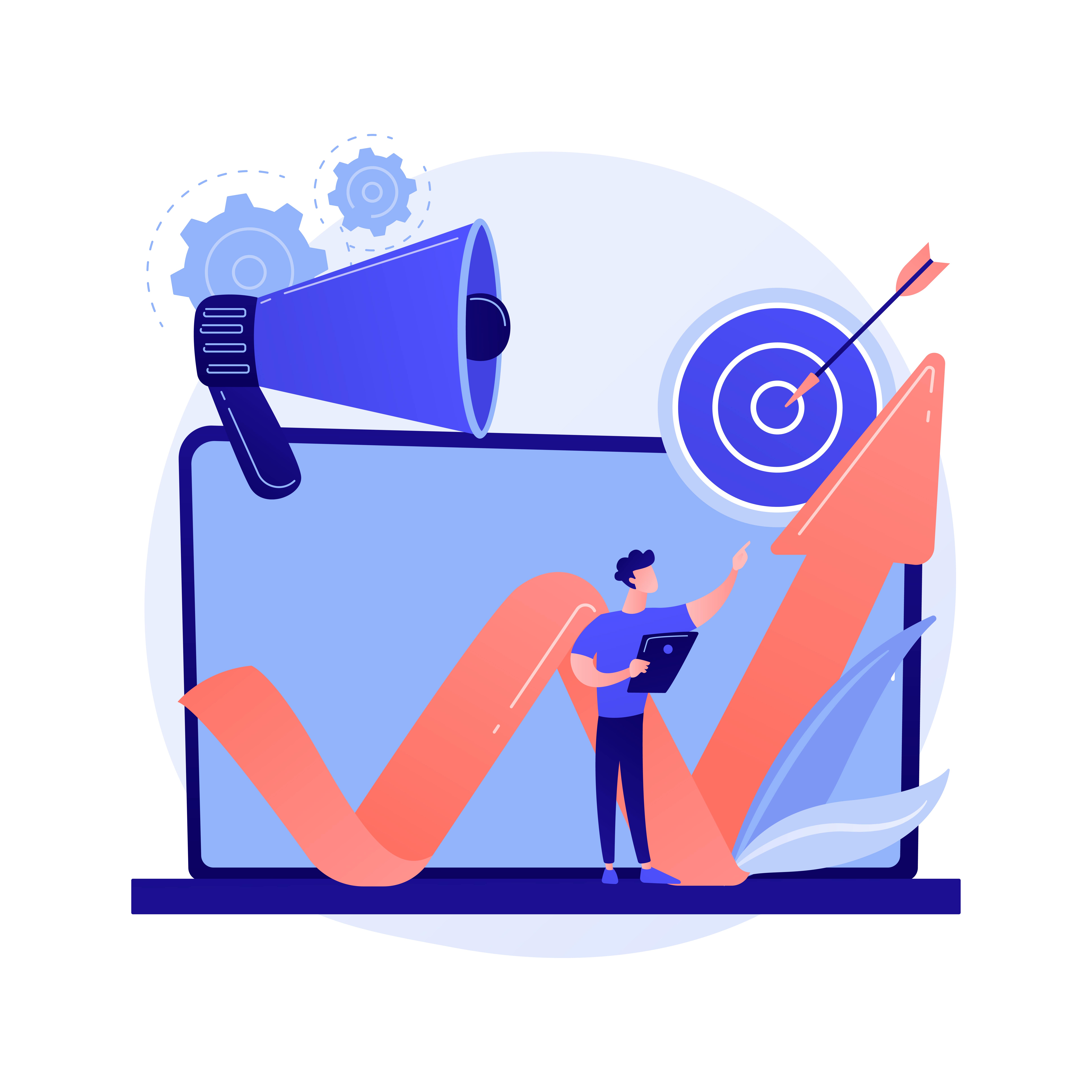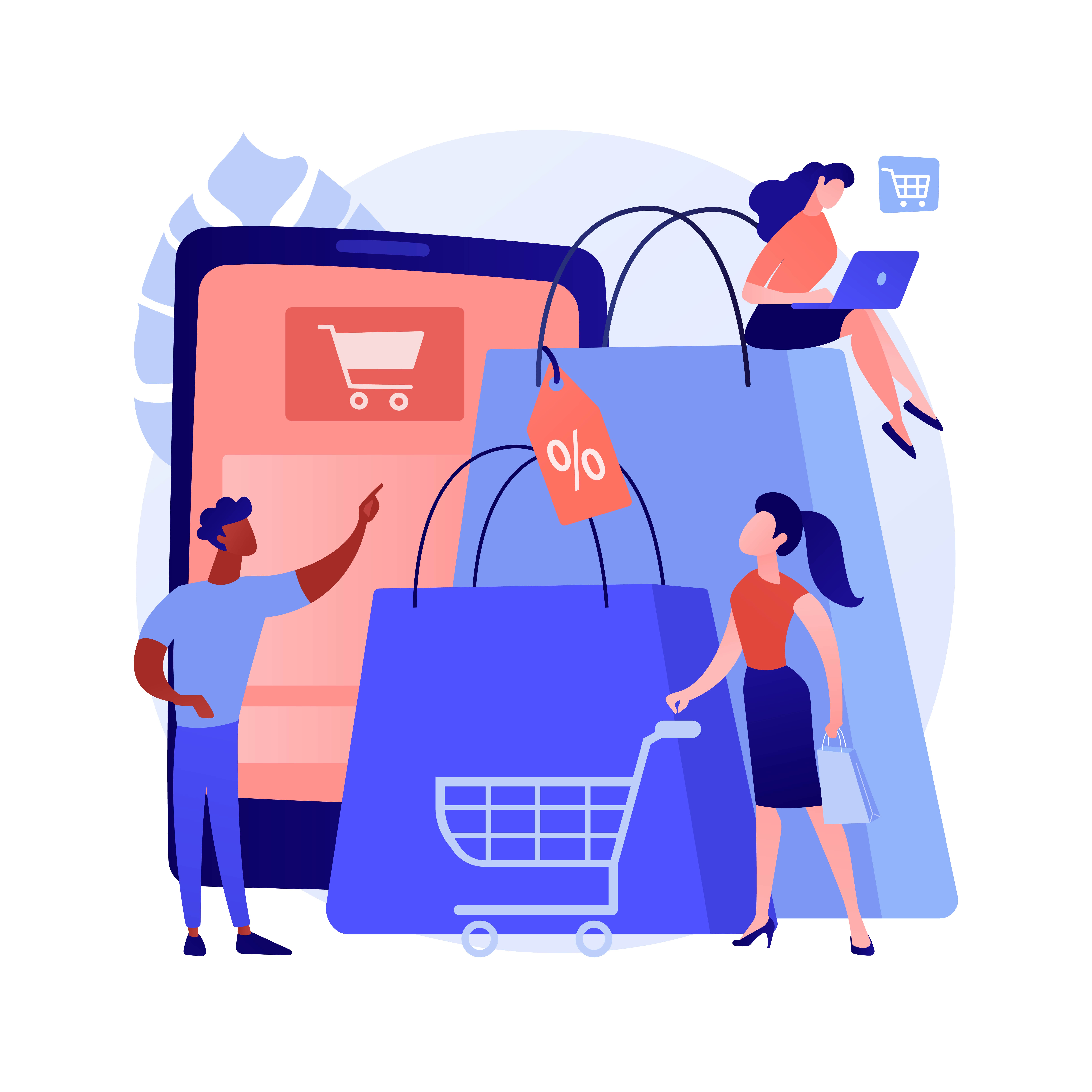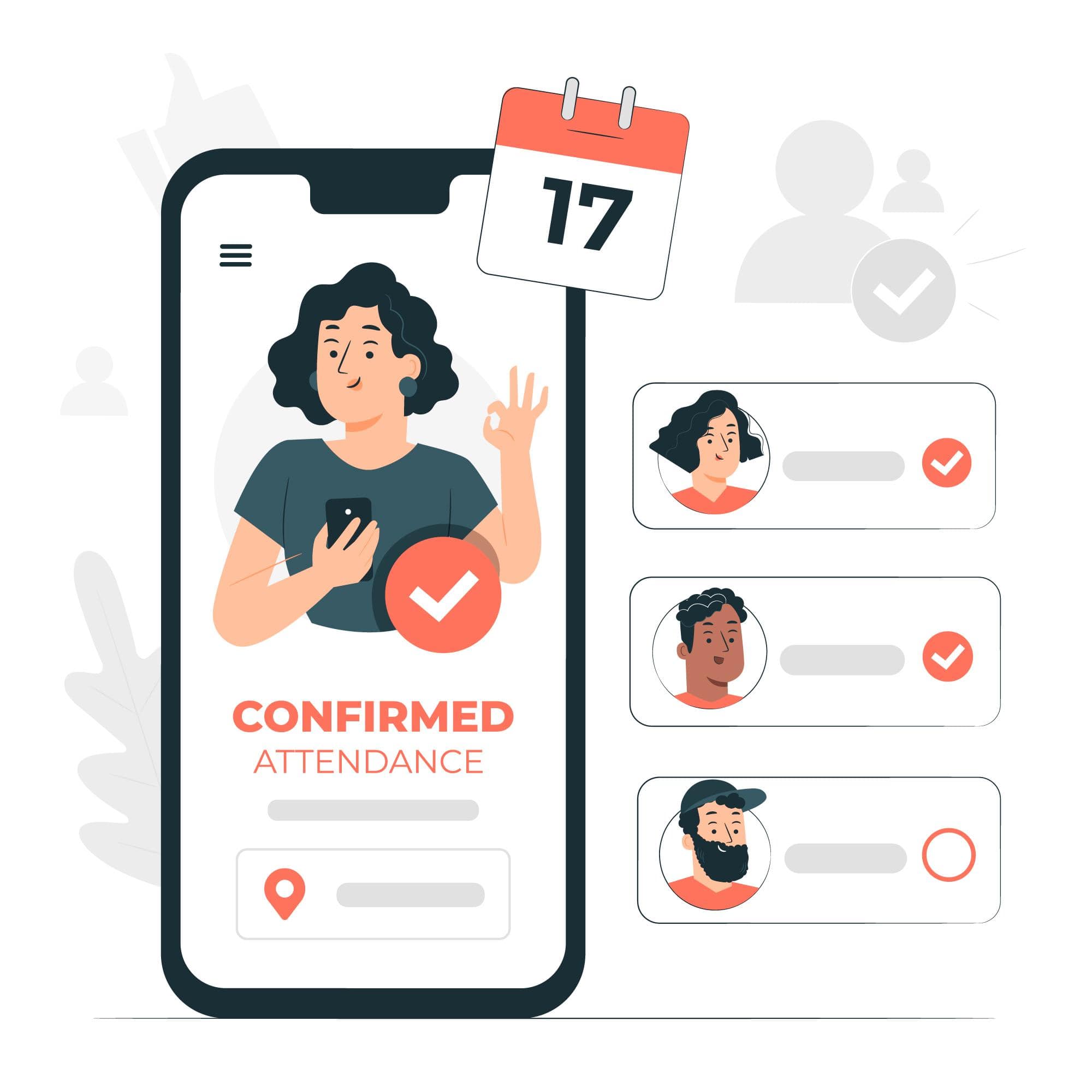In today’s fast-paced digital landscape, the art of converting potential customers into loyal advocates has evolved. Enter sales funnels – the dynamic pathways that guide your audience from initial curiosity to enthusiastic conversions.
These strategic sequences have become a cornerstone of modern marketing, providing a systematic approach to lead nurturing and customer acquisition.
In this blog post, we’ll explore the diverse realm of sales funnels, each tailored to specific stages of the customer journey.
Whether you’re gearing up for a product launch, aiming to build a robust email list, or seeking to engage your audience through compelling webinars, there’s a sales funnel strategy to match your goals. Join us as we dissect five types of sales funnels that can catapult your growth.
Table of Contents
WTF Is A Funnel?
A sales funnel is all the steps that lead someone from hearing about you for the first time to becoming a lead, getting interested in your products or services and buying. Then buying again and again.
What Kinds Of Funnels Are There?
There are five funnels that I use on a regular basis, and I’m going to talk you through them and how to know which one you should use. These funnels are:
- Tripwire funnel for selling info products
- Webinar funnel for setting appointments for services sales
- Webinar funnel for selling online courses
- The sales funnel for services
- Free trial funnel for SaaS businesses
There are a whole lot of other funnels out there (e.g. Ask Funnel, FBA review funnel, FB messenger, Free + Shipping), and there are tons of variations of all these funnels, but these are the ones I find to be the most common.
Get Your FREE Personalized Repor
How They Work And When You Should Use Them
1. Tripwire funnel for selling info products
Tripwire is one of the simplest funnels, but it’s unbelievably underused. Anybody selling an info product should have a tripwire funnel set up.
You’re selling an info product, and you have a lot of traffic coming to your website. You have lead magnets available, and people are signing up for them. What you probably don’t have in place is a tripwire funnel.
So, after somebody originally signs up for the lead magnet, you’re probably just thanking them for signing up. And that’s it.
This is a huge missed opportunity because this is a magic moment in people’s minds.
Just after they’ve signed up for a lead magnet, they’re at this stage where they’ve had a problem in their lives and have been motivated enough to go and search Google. They’ve gone through different listings, and then they’ve found your website. Excellent work!
Now that they’ve come to your website, they had a look around and decided that they trust you and your content. But they wanted their problem solved more, so when they saw a lead magnet available (a cheat sheet, a video course, etc.), they decided to sign up for it.
Now some percentage of those people (usually between 1-5%) actually want their problem solved more thoroughly right now and are willing to pay money to get that solved immediately. And out of those people, some of them will still buy later if you just follow up by email, but definitely not all of them because you lost their attention – you know how many emails we all get nowadays.
So that’s why you should make something available for sale at that stage.
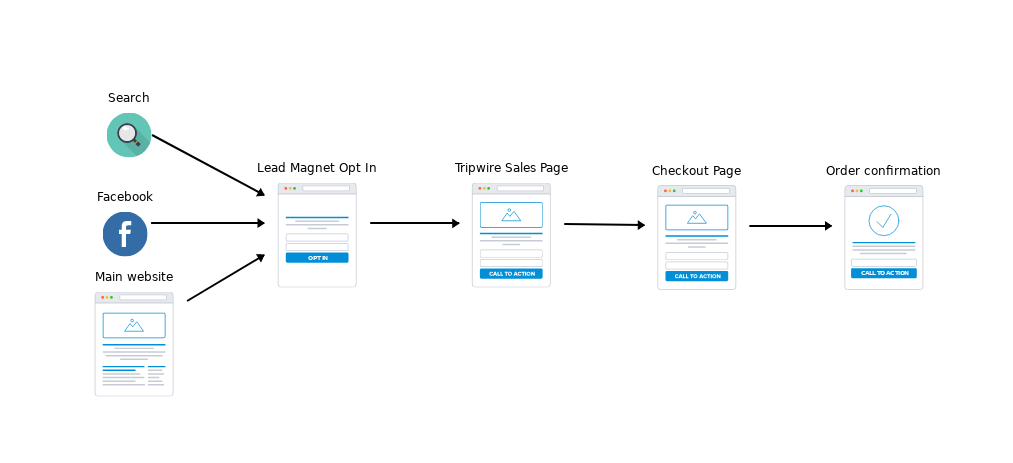
Now some of those people who bought the tripwire actually want something that solves their problem more thoroughly. And you can offer those guys your premium option as an upsell straight after someone’s hit checkout.

However, not everyone will buy the tripwire. Only 1-5% of people will. So you also want to offer the upsell to those people who didn’t get to see it because they didn’t get the tripwire. The easiest way to do this is by setting up an email sequence to promote the upsell.

And some people will drop out partway through the checkout process. So you’ll want to set up a cart abandonment email sequence.
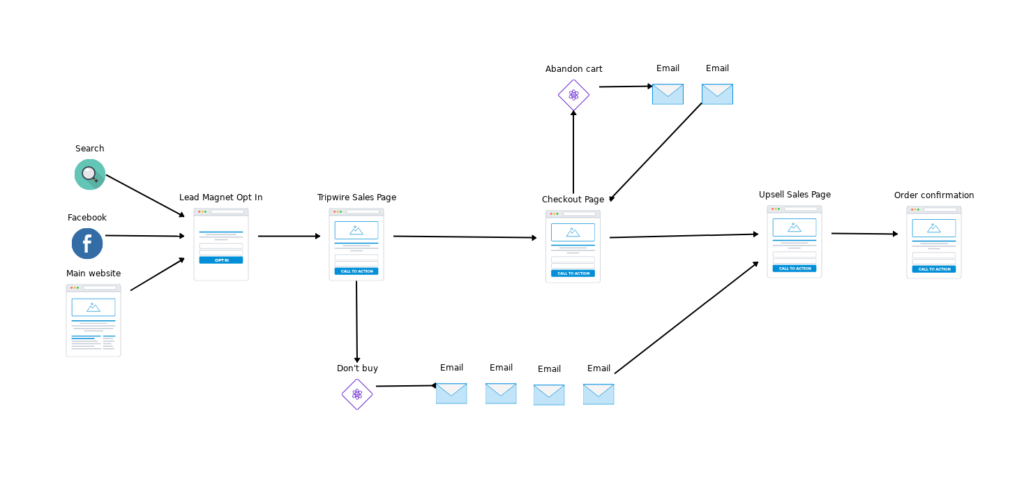
And you can even have that FB retargeting at points where you don’t have their email address.
Then at every stage you want to set up some Facebook retargeting along with the emails to keep people on track.
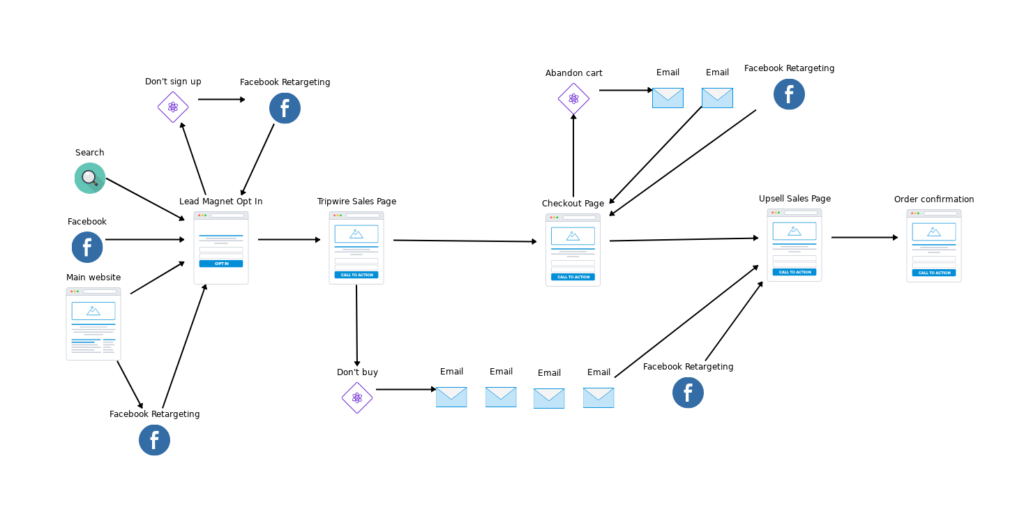
That’s the basic idea of a tripwire funnel.
2. Webinar funnel for setting appointments for services sales

Ok – so another funnel that you might use is the free strategy called webinar funnel.
You’ve got a website with some traffic and you’ve got an email newsletter. Your emails point people to an opt-in. A while later, the webinar happens. At the end of the webinar, you hope that people become clients.

The first thing to add to your funnel in this case is an option to book a call at the end of the presentation. They’ve just listened to the presentation, and they are interested – so make it easy for them to book their free strategy call.

The next thing to do is to add some reminder emails in advance of the webinar so that your registrants are more likely to show up. Even then, only about half the people will turn up live. So you have to set up a replay for anyone who didn’t manage to attend live. This will increase attendance by another 10%.

And then set up more emails after the webinar to promote the free strategy call, and then before the call to remind them to show up.

Now you’ll get all booked up with calls – but not all of those people who book a call with you are going to be good prospects. You need to filter out the good ones, so you will add in an application form, so that they can only book a call if they meet the right criteria.

Lastly, set up Facebook retargeting at every stage to keep people on the right track.
Here is the final version of the funnel:
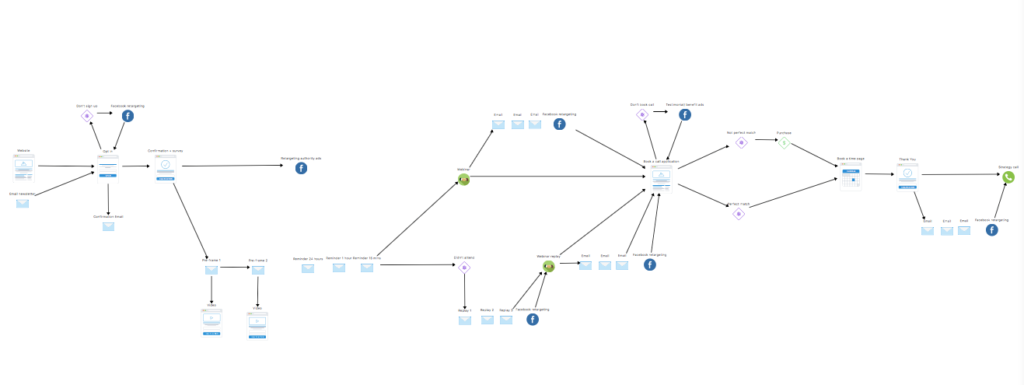
3. Webinar funnel for selling online courses

If you’re selling online courses, this is the ideal sales funnel for you to set up. There are quite a lot of steps in this funnel that most people don’t realise should be included, but they can make a really big difference.
You have a webinar that you’re running. People get to your webinar opt-in page either through Facebook ads, blog posts, Facebook retargeting, your website and newsletter. There will, of course, be people who get to the opt-in page but don’t sign up. So you will be able to get them back on track with Facebook retargeting ads.
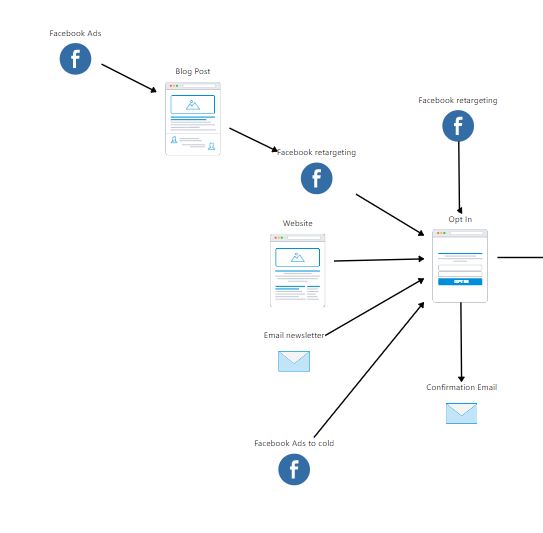
When someone signs up, they are going to be sent to the Thank you page and receive a confirmation email. You are going to be sending them pre-frame emails to make sure that as many people as possible show up for the webinar. At the same time, you would ideally have some Facebook authority ads shown to people who opted in, and the idea of these is pointing people to somewhere on the internet (not on your site) where you have been featured (a podcast, an interview, an article, etc).

Ideally then, someone attends the webinar, and at the end of it they go to the sales page. But if they don’t go to the sales page, you will be sending them a post-webinar email sequence and running some Facebook retargeting ads to point them to the sales page.
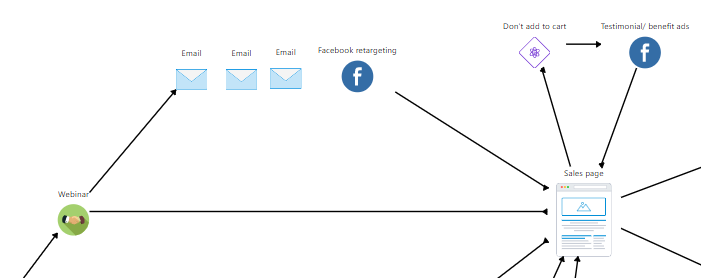
If they don’t attend the webinar, you will be throwing some Facebook retargeting ads and emails at them to get them to watch the replay. After they watch the replay, you are going to send them the post-webinar email sequence and show them retargeting ads to get them to the sales page.
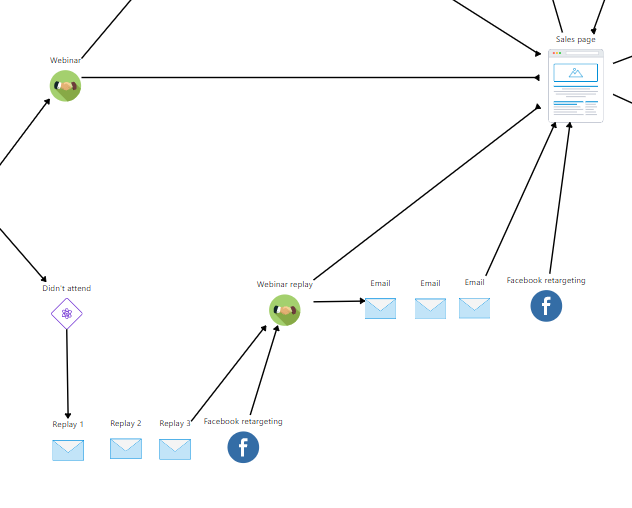
If they go to the sales page but they don’t buy, you are going to want to show them a specific type of Facebook ads – a testimonial ad.
If they add to the cart, but they don’t buy straight away, then you want to show them add-to-cart ads.
If someone goes to the sales page and they add to their cart, and add in their credit card details, you should offer them something extra – an order bump. If they don’t buy the full-price offer, then you should offer them a reduced option one. You could even have a second, different order bump after that. At the end, they reach the order confirmation page.

After they’ve bought, you want to send them an email sequence with useful content that will occasionally point them to the sales page.

4. Free trial funnel for SAAS business
Another type of sales funnel is the SaaS free trial funnel. If you’re a SaaS business owner, this funnel could make quite a difference in terms of your conversion rates from free trials to customers.
So, naturally, you have a product, and you have a website. You’re driving people to your website through guest blog posts, Google searches and Facebook ads. You also have people sign up for your mailing list through a popup on your website.
Some people will go to your free trial page but won’t opt-in. You will want to follow up with them with an email sequence that will eventually take them to the order page. You will also use Facebook retargeting ads to get them to the order page.
Some of these people will opt in for the free trial, but they won’t buy. You will again use Facebook retargeting to get them back on track and take them to the order page. If they reach the order page but don’t checkout – you know what’s next – more Facebook retargeting!

5. The sales funnel for services
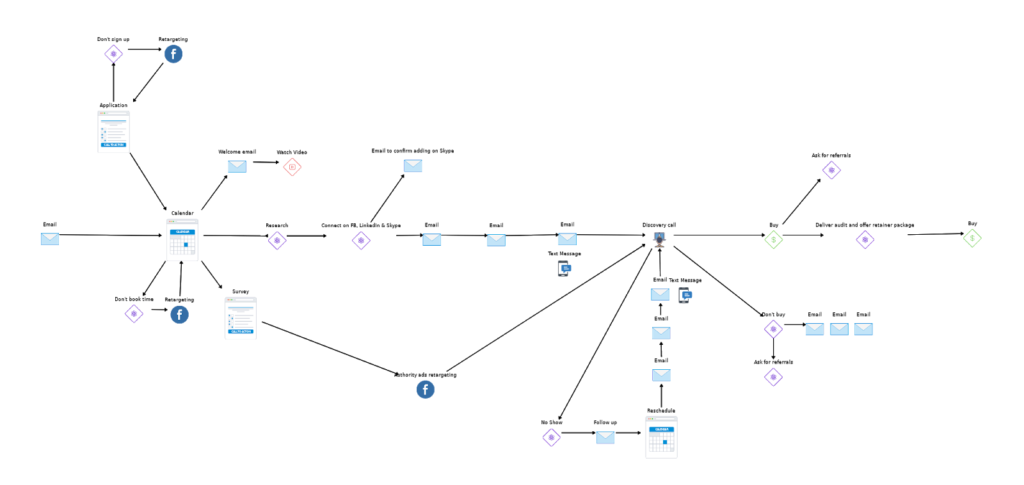
If you’re selling services, you should be able to implement this sales funnel to turn more of your leads into sales.
So, if you’re selling services, you most probably offer a 1-on-1 free strategy session to your prospects. Your prospects come to the page where they can book an appointment with you through various sources – email, website, blog, Facebook ads, etc. However, not all of your prospects would be good leads, so you need to filter them out.
You can do so by adding in an extra step before they can schedule a call with you, and that step would be application. So, only if they meet certain criteria, they will be taken to the call booking page to schedule that free session with you. If they don’t take the application survey, you can use Facebook retargeting to get them back on track. If they meet the criteria but don’t book a call with you, you can point them back to the application again with Facebook retargeting ads.

As soon as they book a call with you, they will be prompted to a survey page where you will want to learn more about them and their business. Anyone who completes the survey, will be shown some authority Facebook ads until the discovery call takes place.
Once they’ve booked a call, they will receive a welcome email and will be shown a summary video about the call where you want to explain to them what they can expect on the call and how to better prepare.
At the same time, you want to do some research about them – connect with them on LinkedIn, Facebook, and Skype, and send them a couple of reminder emails to make sure they turn up for the discovery call with you.
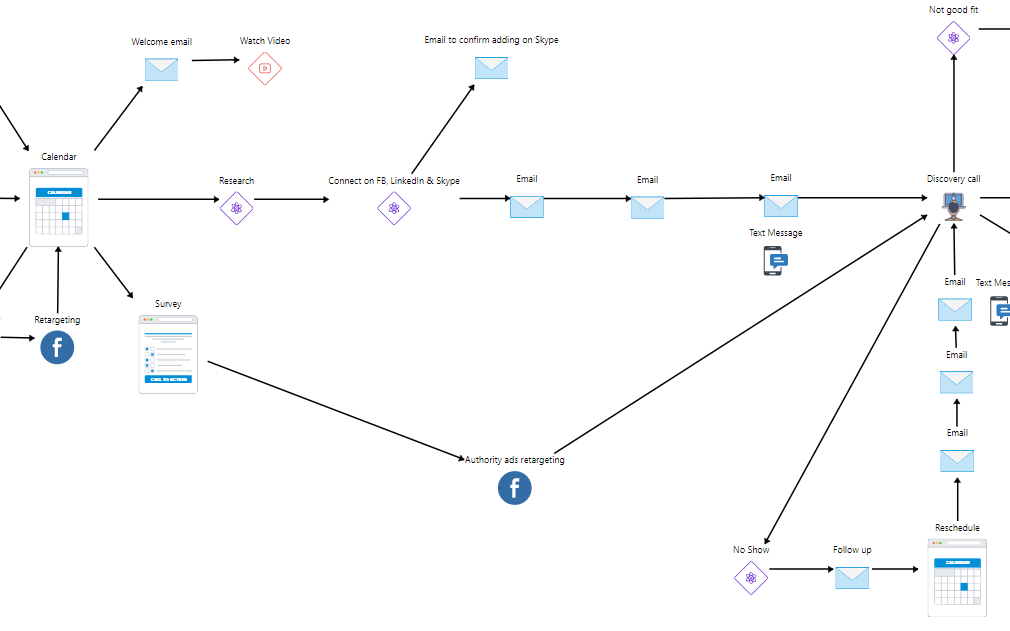
Ideally, after the discovery call, they will sign up for your services and then you’ll have a chance to offer them an upsell. You will also want to ask them for referrals at this stage.
If they don’t buy, you want to follow up with them via email. If they are not a good fit for your services and company, maybe they know someone who is, so make sure to ask for referrals in this case as well.
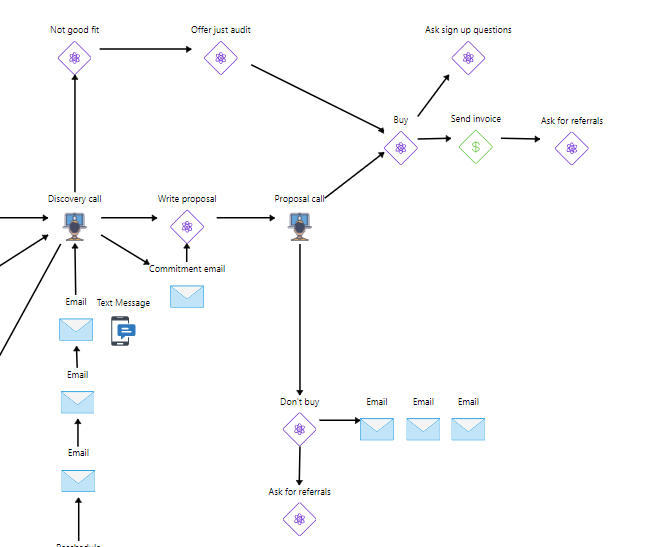
There will be cases when someone books a call with you and then they don’t show up on the call. You want to follow up with them and give them the option to reschedule. Once they do, send them a couple of reminder emails to make sure they turn up for the discovery call with you this time.

Hopefully, that gives you an overview of what funnels are and which one you should use in your business in order to make more money from it.
If you need any help with planning, setting up or automating your sales funnel, just get in touch.
Frequently Asked Questions
- What is an automated sales funnel, and how can it benefit my business?
An automated sales funnel is a system that guides potential customers through various sales funnel stages (0/1–3) without constant manual intervention. It uses tailored content and responses to nurture leads, eventually converting them into paying customers.
2. How does a reverse squeeze page funnel differ from a traditional squeeze page funnel?
While a traditional squeeze page funnel aims to collect email addresses from potential customers, a reverse squeeze page funnel takes a different approach. It provides value first and then asks for contact information, fostering trust and engagement before the exchange.
3. What makes a successful sales funnel strategy?
A successful sales funnel strategy encompasses a deep understanding of your target audience, seamless integration of different funnel types, and compelling content that guides potential customers through the stages from awareness to becoming paying customers.
4. Can you explain the concept of a sales letter funnel?
Certainly! A sales letter funnel is a type of funnel that uses persuasive written content to lead potential customers through the buying process. It’s designed to address customer pain points and showcase the benefits of your product or service, ultimately converting leads into paying customers.
5. How can these funnel types help me turn potential customers into paying customers?
Each funnel type targets specific stages of the customer journey. Whether it’s offering value through a lead magnet, engaging with webinars, gathering insights through surveys, or using automated systems, these funnel types guide potential customers toward making purchasing decisions.


